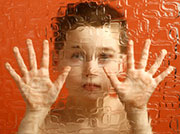
THURSDAY, March 27, 2014 (HealthDay News) — One in 68 American children is now diagnosed with autism or a related disorder, federal health officials reported Thursday.
That’s a 30 percent increase from just two years ago when the estimate was one in 88 children, according to a new report from the U.S. Centers for Disease Control and Prevention.
“The number of children identified with autism continues to rise,” said Coleen Boyle, director of the CDC’s National Center on Birth Defects and Developmental Disabilities.
The continuing increase in the percentage of kids diagnosed with autism could be due to better detection of the developmental disorder, Boyle said, but also might reflect an actual increase in autism.
“It could be a combination of better recognition and increased prevalence,” she said. “Our system tells us what’s going on. It only gives us clues about the why.”
The new statistics also continue to show that autism spectrum disorder is five times more common among boys than girls. And they reflect an increase in the percentage of children being diagnosed with high-functioning autism, the CDC said.
People with an autism spectrum disorder display impaired social and communication skills. Symptoms, which can range from mild to severe, usually become apparent in the first three years of life. The developmental disorder is linked to abnormal biology and chemistry in the brain, according to the U.S. National Institutes of Health.
The agency bases its estimates on reports from 11 communities that participate in its Autism and Developmental Disabilities Monitoring Network. The newest estimate is based on data from 2010.
Estimates of autism among 8-year-olds have more than doubled since the CDC network’s first report in 2007, which calculated that about 1 in 150 children had the disorder based on 2002 data.
The continuing rise of autism highlights the need for more funding for research into the causes of autism and for support and treatment of kids diagnosed with the disorder, said Michael Rosanoff, associate director of research and scientific review at Autism Speaks.
“We really need to double down on our research into the environmental factors that work in some complex way with a child’s genetics to increase the risk of autism,” he said.
There also needs to be continued emphasis on earlier diagnosis of autism, added Dr. Melissa Nishawala, an assistant professor of child and adolescent psychiatry at the NYU School of Medicine and medical director of the Autism Spectrum Disorders Clinical and Research Program.
The new CDC study reports that most children are diagnosed with autism spectrum disorder after age 4, even though autism can be diagnosed as early as age 2.
“We need to push the frontier of diagnosis down to the earliest ages we can,” Nishawala said. “The earlier we intervene, the more we can do to help nudge those brain pathways closer and closer to normal.”
Autism experts believe the increase reported by the CDC is more likely due to improved detection of the disorder, particularly among children at the higher-functioning end of the autism spectrum.
For example, almost half of children identified with autism spectrum disorder in the new study have average or above average intellectual ability, compared to one-third of children a decade ago.
“We are looking much more carefully, and we are getting better at finding kids at both ends of the spectrum, in particular the higher end of the spectrum,” Nishawala said.
At the same time, the experts believe there are likely even more kids with autism than reported, given possible flaws in the CDC’s surveillance system.
“We feel the way the CDC measures autism misses cases and is under-representing it,” Rosanoff said. “This new number doesn’t surprise us, but we feel it still may not be an accurate reflection of the true public health challenge.”
The CDC network tallies cases that come to the attention of physicians or educators, which then are verified through a comprehensive evaluation and a review of school and medical records. But if the case doesn’t attract attention, or if records aren’t available to substantiate the diagnosis of autism, then the network will overlook that case, Rosanoff said.
For example, autism rates vary widely from state to state, ranging from one in 175 children in Alabama to one in 45 children in New Jersey — an indication that some states are doing a better job of detecting and tracking autism. So, the total estimate could be skewed, Rosanoff said.
“All of the variation in prevalence between sites is due to the quality of records between sites,” he said. “Those sites with better records have higher prevalence. In places where detection isn’t as good, you’re going to have a lower number.”
These discrepancies also could explain why white children are much more likely to be diagnosed with autism, Nishawala said.
The new CDC report found that white children were approximately 30 percent more likely to be identified with autism than black children and almost 50 percent more likely than Hispanic children.
The CDC report was published in the March 28 issue of the agency’s Morbidity and Mortality Weekly Report.
On Wednesday, researchers reporting in the New England Journal of Medicine said children with autism show key “patches of disorganization” in the outer layers of the brain. The researchers said this offers more evidence that the developmental disorder begins in the womb.
Researchers have managed to find a few hundred genes that are linked to autism risk. And although there is no definite environmental culprit, studies have tied certain factors during pregnancy to an increased risk, including exposure to high levels of air pollution, low intake of the B vitamin folate and viral infections.
More information
For more on the Autism and Developmental Disabilities Monitoring Network, visit the CDC.
Copyright © 2025 HealthDay. All rights reserved.

